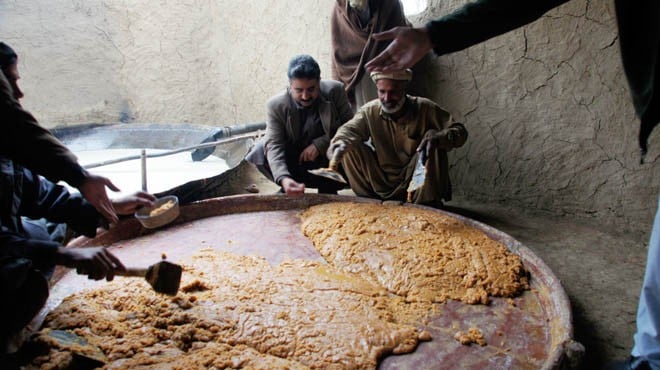

It is gur-making season in Khyber Pakhtunkhwa, especially in Peshawar, Charsadda, Mardan and Nowshera. The estimated sugarcane production in KP is around 1.3 million tonnes. Almost half of it is used for gur making. Gur produced in Charsadda and Mardan is very popular countrywide.
Gur is the main sweetener for around 60 per cent people in KP and Federally and Provincially-administered tribal areas (Fata and Pata). It is exported to Afghanistan, Middle Eastern and Central Asian states where it is believed to be used as a sweetener and in winemaking.
Thousands of tonnes of gur is traded in the province or taken out of the country daily. Majority of the sugarcane growers prefer using their cane-produce for gur-making rather than taking it to mills for its comparative advantages. It fetches them good prices. They have to feed their animals with cane-grass which necessitates intermittent cutting of crop as allowed by gur-making and not simultaneous harvesting of the entire crop as demanded by the mills option. And they usually use gur in their homes. Gur is used in juices, sweets and eaten with bread as curry with bread by the poor.
In Punjab, a kind of gur, named Duplicate, is prepared by mixing gur, glucose and other ingredients. It is good-looking as well as cheaper and tasteful, according to some farmers.
While sugar-mills began crushing season in early November, gur-making is usually started in late September or early October. It lasts till April next year.
Gur prepared in the initial stage is of inferior quality but can fetch more. Late production increases yield and standard. The gur made in January, February and March is much better in quality and is liked the most. Similarly, gur without alteration is the best for human consumption while that mixed with artificial colour tastes bad, though people residing in remote areas prefer it for its bright colour. Again, the gur made from the roots of the last year’s crop is good in quality while that from fresh canes is not that good.
According to Murad Ali Khan, a farmers’ leader from Charsadda, gur is more competitive for the farmers at the current rate.
"A pur of gur (having 75-80 kilograms) fetches a price up to Rs5000 depending upon its colour, taste and quality in the local market. Sugarcane yield per acre is around 400 maunds which can produce 20 purs (a pur consumes 20-25 maunds of cane). These can earn a farmer Rs100,000 or more. It exceeds the price offered by sugar-mills these days," he says.
According to another farmer, quality sugarcane can give as much as 40 purs per acre. But, he says, farmers in KP will only benefit from the crop when its per acre yield of 350-400 maunds is increased to that of 650-700 maunds in Punjab. At present, gur-making through rented gur-ganee (machines) is less beneficial for farmers while those who own ganees are the real beneficiaries," he opines.
Muhammad Zahir Khan, another growers’ representative, says hitches in supply of gur to Fata, Pata and the ban on export of gur to Afghanistan and the central Asian states, however, have lowered gur prices of late to the detriment of gur farmers. "Gur can be a healthy addition to the countries’ depleting export earnings if its export is allowed after value addition."
Masud Khan, the manager of the Premier Sugar Mills Mardan, says though the minimum sugarcane support price is Rs170 per 40 kilogrammes in other provinces, the local sugar mills offer Rs180. "We have to compete with gur-ganees. While our per kg cost of production has increased for higher prices and wages offered to farmers and employees, escalating fuel prices and various taxes, gur-ganees have no such taxes and responsibilities. How can we compete with them? Sugar industry will be on verge of closure if not supported," he says. The industry has been campaigning for ban on gur export, taxes on gur industry and eventual moratorium on gur production.
Rizwanullah Khan, the president of the Kissan Board KP, however, says prices of all the things are on the rise while last year’s cane price has remained unchanged. "In 2010, mills had offered Rs240 per 40kg. Cane price be increased as per cost of production. We have planned agitation to press for good cane-prices."
Gur was once the food of the poor. Though it has become costlier than sugar for few years now, the poor still prefer it for its taste and health benefits.
A farmer said gur agents and big farmers have installed generator-run modern gur-ganees with several furnaces which help prepare plenty of purs daily.
In 1996, average retail gur price was 14 rupees a kilo. Currently, it is sold at Rs66-75/kg. The sugarcane growers, unfortunately, haven’t been able to get advantage of this hike. Growers say the gur commission agents have devoured most of the surplus value in the shape of huge commission or deduction of 5-8kg gur/a pur.
Mardan and Peshawar are the hubs of gur trade. Around ten to twelve thousands of purs are traded in the Pipal Mandi gur market when the trade is in full swing. Gur commission agents work pretty much like the property dealers or motor vehicle bargainers who are only concerned with their commission.
"The gur agents enter advance agreements with farmers by making payments for standing crops. They provide farmers seasonal/crop-based loans which they use for buying inputs and fulfilling their domestic needs," a farmer says.
An official of the Sugarcane Crops Research Institute said though KP’s cane has better quality and sucrose content, its average yield is between 16-24 metric tonnes, much less than that of Sindh and Punjab. He cited insufficient use of fertiliser and pesticides, non-attractive price given by mills, intercropping, use of less than recommended seed (4 ton/acre) and shortage of irrigation water as reasons for lesser acreage and production.